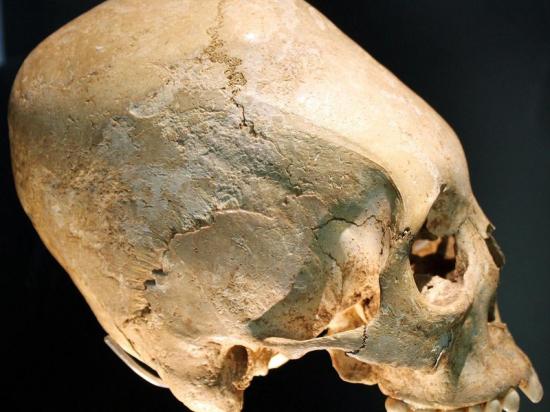A new find in Patagonia adds to the list of possible reasons for such extreme cranial modification
Marissa Fessenden
Source - http://www.smithsonianmag.com/smart-news/parents-have-been-reshaping-their-kids-skulls-45000-years-180957343/#YciBDIaa0EjyXclA.99
 A modified human skull from the early 6th century (Anagoria via Wikimedia Commons (CC BY 3.0))
A modified human skull from the early 6th century (Anagoria via Wikimedia Commons (CC BY 3.0))
For thousands of years, various communities around the world have bound cloth or pieces of wood to the pliable heads of infants to artificially elongate or otherwise shape their craniums. Neanderthals living 45,000 years ago show the evidence of such skull shaping, and the practice persists among some societies today.
While human adults have hard heads, babies’ skulls are still quite soft when they are born, thanks to gaps between the bones of the head. Cranial pliability arises from the need to squeeze such a large braincase through the birth canal. The spaces between bones also help human brains (along with those of our close relatives, chimps and other apes) have space to grow after birth, faster than bones can. Because of this physiology, if parents let their baby rest in the same position during their first months, a flattened spot might form, though this doesn’t affect the baby’s growing and developing brain.
It’s exactly that kind of accident that may have sparked intentional cranial deformation in cultures spanning Central America to Europe to Asia.
For example, some Native Americans put their children in protective cradles sporting flat boards around the head, so they didn't have to worry about the baby. At first, deformation could have been unintentional, explains archeologist Mercedes Okumura of the Federal University of Rio de Janeiro in Brazil. After some time, people realized that this process caused babies' heads to flatten and, liking the results, they began to use the wood cradle in order to get an intentionally deformed skull, she tells Melissa Hogenboom for BBC.com.
Experts speculate that the widespread tradition could stem from a host of motivations, not the least beauty. The latest hypothesis to join the list, however, is the belief that skull shaping could have been a boon for survival to some who practiced it, as proposed by Marta Alfonso-Durruty, an anthropologist at Kansas State University, and colleagues in a new research paper published in the American Journal of Physical Anthropology.
The team examined 60 skulls from a group of hunter-gatherers that lived in Southern Patagonia and Tierra del Fuego 2,000 years ago, Hogenboom writes. Thirty percent of the skulls showed signs of intentional deformation, the first evidence that people in Patagonia practiced such modification, which could have become widespread because, like tribal tattoos or team jerseys, it promoted group cohesion. Unlike clothing, however, body modification permanently differentiates in-group members from outsiders.
In Patagonia however, the hunter gatherers with modified skulls lived in more diffuse groups, created by the need to move from place to place in search off food in a resource-scarce region. Building relationships with individuals to gain access to certain areas would have been valuable. Modified skulls could have served that purpose, signaling a trusted, connected person. Hogenboom elaborates:
[H]aving an oddly-shaped skull proved they had acquired information on how to do so from another trusted group. "It was a social strategy that allowed individuals to access resources, that were at times unpredictable, across a large territory," Alfonso-Durruty says.
The practice has also extended into modern times. In a region of Western France, people were still binding the heads of their children in the early 1900s. The practice, called bandeau, was thought to protect the infants from accidents and may or may not have been intentionally creating the altered head shape that experts called the "Toulouse Deformity." Chris White reports for Atlas Obscura that people in Russia, Scandinavia and the Caucasus also practiced cranial deformation at that time. Today, some groups in Polynesia as well as the people of the Mangbetu tribe in Congo still sometimes elongate their children’s heads.
In a way, bounding and molding the skulls of infants is part of our heritage as human beings. After all, it’s a practice that has persisted for much - if not all - of our history.